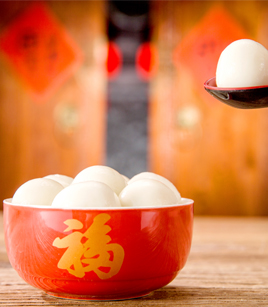Lantern Festival

Yuanxiao, or tangyuan, a Chinese dessert traditionally eaten during the Lantern Festival Photo: CFP
The origin of this festival is still uncertain. Confucianism, Taoism, and Buddhism, which constitute the essence of traditional Chinese culture, contain different interpretations of the Lantern Festival. Confucianism associated the origin of the Lantern festival with the worship of Taiyi, the God of Heaven. According to this interpretation, the enjoyment of lanterns on the night of the fifteenth day of the first lunar month is an inheritance that has been passed on from Emperor Wudi of Han (156–87 BCE), who worshiped Taiyi on that day and celebrated throughout the night. The Taoist followers believed that the birthday of Tianguan, a Taoist god responsible for good fortune, falls on the fifteenth day of the first lunar month. In the Buddhist tradition, the events commemorate the Buddha’s display of miracles for his disciples, which fell on the fifteenth day of the first lunar month.
It is hard to decipher the true origins of the Lantern Festival, but one thing is certain: festivals were deeply rooted in the lives of ancient people and kept evolving as civilizations developed. In addition to lantern displays, the biggest attraction of the festival, there are many other interesting traditions and customs for this festival. The most popular food of that day is a ball of glutinous rice flour with sweet filling. In northern China, it is called yuanxiao, while in the south, it is known as tangyuan. The round shape of the balls symbolizes family unity.
Guessing lantern riddles is another essential component of the festival. Riddles are written on lanterns. If the riddle is answered correctly, the solver earns a small gift. This activity is believed to have emerged during the Song Dynasty (960–1279). During the daytime, people often celebrate the festival with performances, such as the dragon dance, lion dance, land-boat dance, and stilt walking. The land-boat dance is said to commemorate Yu the Great, a legendary emperor who successfully led the people to fight floods in ancient times. The land-boat dance symbolizes various boating movements on land. The boat is not a real one, usually made of two pieces of thin bamboo hewed into the shape of a boat, covered with colorful cloth and tied around the waist of the performer, creating the illusion that the performer is rowing a boat.
Edited by REN GUANHONG
